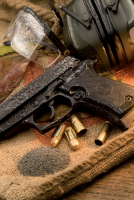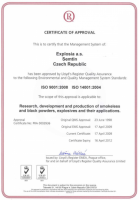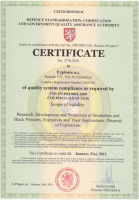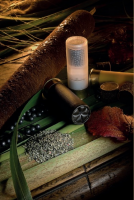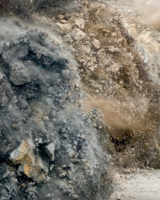
Categories
- Metal Processing, Parts & Components
- Other Aerospace, Defence and High Technology related companies
- Services (R&D, training, engineering, consultancy, …)
- Weapons & Ammunition
EXPLOSIA a.s., is production and trading company operating in the field of production of explosives, ammunition and providing the services, connected with application of energetic materials for commercial as well as military use.
The company with original name “Czechoslovak Joint-Stock Factory for Explosive Materials“ was established in 1920, and this year celebrates the 85th anniversary. Name Explosia, used first unofficially only, was adopted in 1934. During its existence Explosia has gone through a number of organizational changes. An important step in modern history of Explosia was the rise of joint-stock company Explosia in 1998 and its consequent property split-off from Aliachem a.s. At present time, 100% Explosia a.s. shares are owned by the state.
Explosia a.s. holds an important position in the field of production of explosives and propellants not only in the Czech Republic, but it is also an important exporter of propellants, commercial explosives, ammunition and special pyrotechnic products.
Explosia a.s. produces a wide assortment of qualified commercial explosives for open pits blasting, explosives designed for underground blasting, special plastic explosives for military use, smokeless powders for both commercial and military use and a number of other products, out of which it is possible to mention e.g. modular charges for weapons of calibre 155 mm, subcalibre ammunition of calibre 125 mm, pyrotechnic components for aircraft rescue systems, plastic explosives etc.
Contact info #1
DRILLING & BLASTING
Drilling and blasting services are all the services necessary for the preparation and carrying out of blasting and are provided with various degrees of complexity.
They consist primarily of drilling works, supplies of explosives and initiators to the blasting sites, blast master works and providing blasters, including the charging service, loading and transportation.
RESEARCH, DEVELOPMENT & TESTING
In the field of research, development and testing of industrial and military explosives we offer performance of special tests, especially:
- Determination of presence of trace quantities of explosives e.g. in soils, waters, on contaminated objects
- Determination of chemical composition of unknown explosives
- Determination of chemical stability of explosives by means of all commonly used methods including vacuum test
- Determination of compatibility of explosives
- Study of heat flows by means of monitor of thermic activity (microcalorimeter)
- Determination of heat of explosion
EXPLOSIVES TEST ROOM
Test Room for Explosives carries out verification of function parameters of explosives with simultaneous ensuring of in-process and final inspection of their production. At the same time the Test Room ensures passing judgments and verification of properties of explosive compounds for a wide range of customers.
The company offers:
- Determination of detonation capacity of industrial explosives
- Determination of critical diameter of charge
- Determination of effects of explosives to Trauzl
- Determination of relative effectiveness of industrial explosives in ballistic mortar
- Determination of brisance by lead block compression test
- Determination of detonation transmission of industrial explosives
- Determination of detonation velocity of industrial explosives
- Determination of the grade of water resistance of industrial explosives for classification purposes
- Determination of detonation capacity of industrial explosives exposed to water pressure
- Classification and methods of testing of permissible explosives in explosive mixtures
- Determination of resistance of permissible explosives with respect to deflagration
EXPLOSIVE WELDING OF METALS
Activities of the group of high dynamic pressures are concentrated on development and manufacturing of explosive welded bimetallic and multilayer metallic materials, primarily half-finished products and structural elements in the shape of plates, rods and tubes. The method of explosive welding (cladding) makes it possible to manufacture all area welds between practically arbitrary metal combinations regardless of their possible unweldability if classical methods are used. Basic condition of applicability of explosive operation is certain minimum drawability of both connected materials.
Most applications represent circular semi-products for manufacturing the tube plates for heat exchangers from construction carbon steels of Classes 11, 12, 13 and 15 cladded with corrosion-resistant steels, copper and its alloys, titanium, aluminium, nickel and its alloys etc. Cladding can be carried out as one-side, both-side or all area workmanship, the process does not bring along any limitations as to area and thickness of the processed material.
Similarly bimetalic sheets are manufactured for production of vessels (including pressure vessels) for chemical and foodstuff machinery. In case that bimetals of large area dimensions are needed, prior consultations on feasibility are always necessary, taking into consideration required layers thicknesses. The possibility can be advantageously used of explosive welding of semi-finished products for consequent hot or cold rolling down; this procedure is used especially for combinations of noble materials for electrotechnique.
A special application is preparation of bimetalic semiproducts of glass moulds, using cladding of nickel sheet onto the fronts of the cylinders (discs) from construction steel . Similar process is manufacture of cylindrical elements with the front cladded with sliding material for hydraulic converters.
Explosive welding is also used for preparation of bimetalic or multilayer elements applicable as transition joints for subsequent fusion welding of constructions from the materials that are not interweldable in a classical way, e.g. steel and aluminium.
Out of cylindrically shaped semi-products mostly applied are the necks with explosive welded-in-lining, used for bimetalic vessels from the same materials combination; most often it is the lining from corrosion-resistant steel in the bores of forgings from steels of Class 11 and Class 15.
PROPELLANTS
Explosia a.s. produces two basic types of powders - single base (nitrocellulose) powders and double base (nitroglycerine) powders with various nitroglycerine content. For special applications nitroguanidine based triple base powders are also produced, used mainly for 125 and 155 mm tank ammunition.
According to production technology flake, disc, cylinder, tube, seven perforated or spherical powders are produced. Explosia a.s. also produces many various types of powders for most of present types of ammunition.
Single base powders (marked S)
- Flake and disc porous powders
- Tube powders
- Seven perforated powdersCombustible cases for large calibre ammunition
Basic component of single base powders is nitrocellulose (90-98%). On their production, various additives are used as chemical stabilizers, compounds for surface treatment, muzzle flash reducing compounds and burning modifiers. Powder grains can have a form of cylinders, tubes, flakes, discs or multi perforated cylinders. Many of these powders are surface treated using compounds serving to achieve better burning parameters. Single base powders are used for small arms ammunition, guns, mortars, canons, howitzers and in other special applications in various industrial branches.
Double base powders (marked D)
- Flake and disc powders
- Spherical powders (ball or rolled, compact or porous)
- Tube powders
- Ribbon powders
- Rocket powders
Apart from basic nitrocellulose, double base powders contain - as energetic component- nitroesters, usually nitroglycerine (10-38%). The powders further contain small quantities of chemical stabilizers or other similar compounds as it is with single base powders. Double base powders can be of higher energetic content than single base powders. Their calorific value varies - according to the type - within 3, 800 - 5, 200 kJ/kg. From the users's point of view, their ballistic and other properties are usually more interesting than these of single base powders. Powder grains can be in the form of cylinders, tubes, flakes, discs, ribbons or spheroids.
Reloading powders
The reloading propellants were specially selected from many different propellants, which we produce, to be able to cover usage in all commonly used calibres.
Smokeless powders for military applications and ammunition
Smokeless powders for military applications are produced according to relevant military standards NATO, or according to technical specifications for deliveries for producers of military ammunition.
Product informational files
EXPLOSIVES
Explosives for opencast mining
Explosives for opencast mining are industrial explosives intended exclusively for works on surface workplaces. These explosives are usually supplied in explosive charges of a large diameter packaged in polyethylene, but opencast explosives can also be made and supplied by means of surface trucks.
An initiating charge of a brisance explosive is usually used for initiation. If these explosives are in cartridges, they are denoted by their yellow colour.
Explosives for underground mining
Explosives for underground mining are industrial explosives also intended for underground use, namely in environments without the danger of explosions of gases, vapours or dust.
Explosives for underground mining are supplied in paper cartridges, in charges packaged in polyethylene or in volume packaging. These explosives are denoted by their red colour.
Permissible explosives (Permitted Explosives)
Permissible explosives are industrial explosives intended for mines with a different measure of danger of the incidence of explosive mixtures of fi redamps and coal dust with air. They are supplied in paper cartridges.
These explosives are designated by colours depending on their classifi cation from the point of view of the safety in mines. Safe underground explosives of category II are denoted by their green colour, explosives of category I by their white colour.
Explosives for special use
Explosives for special use are intended for use, for example, during blasting works under pressure, under water, during geoseismic surveys and for destruction and other special works. Some of these explosives are used as initiating charges.
Black powders
Black powders are a mixture of potassium nitrate, sulphur and charcoal. They are used as powders for blasting, timing, pyrotechnical purposes, in hunting ammunition and for fi ring from vintage fi rearms.
STARTLINE detonating cords
STARTLINE detonating cords are igniters charged with high explosive penthrite. They are used primarily for ensuring the transmission of detonation.
Mixing and pump trucks
Mixing and pump trucks are a modern means of blasting technique that transport inexplosive components or mixtures thereof to the consumption site, where they prepare the explosive by mixing and sensitizing it and charging it into the shot-holes at the same time.
Product informational files
SPECIAL PRODUCTS
Complete assortment of pyrotechnic components for aircraft rescue systems designed for aircraft AERO L-39, L-59 and L-159, especially rocket motors URM serving to accelerate the rescue seat on catapulting, rocket motor ROP designed to release the aircraft canopy and other types of pyrotechnic means.
Pilot plant production of a wide assortment of energetic compounds serving as components for production of explosives and propellants with high added value, for development and research of new types of gas generators, propellants and special explosive systems.
DMNB, used as detection additive for plastic explosives both for our own need and for export.
High quality plastic explosives for application in military and police bodies and other products used for special blasting and demolition work.
Explosia a.s.
- Semtin 107, PSC 530 50, Pardubice, Czechia
- +420 466 825 227
- explosia@explosia.cz
- www.explosia.cz

